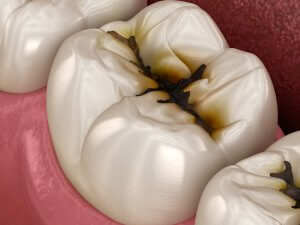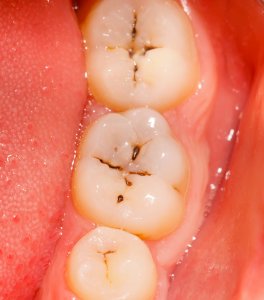Have you got questions about dental fissure sealant? The term may be unfamiliar but the good news is it’s a simple preventative procedure that’s performed to help protect teeth from decay. Best of all, it’s completely pain-free and is free on the NHS for children.
Fissure sealant is most often applied to children and teens when their adult teeth first erupt, but it’s not just for pediatric dentistry. In many cases, adults can have their teeth sealed too.
Here we’ll explain exactly what the fissure sealant procedure involves, what it costs (both on the NHS and privately), and what you should consider before going ahead.
When new molars appear in a child’s mouth, they are highly susceptible to cavities. Based on the typical diet of a child and newly formed brushing habits, or lack thereof, cavities can be easy to come by in children between the age of 5-14. One of the best ways to help young molars prevent cavities is with dental sealants.
This is a harmless filler that coats the teeth and prevents bacteria from causing decay. It will wear down and the effectiveness will decrease over time, so it is recommended that patients reapply every 2-4 years.
The cost of dental sealants is about a third of the price on average of filling a cavity. Cavities can also lead to other problems such as loss of teeth, gum disease, and nerve damage, which can add to your dental costs over time. Dental sealants can be up to 80% more effective at cavity prevention for the first 2 years.
Therefore, reapplying every couple of years can be a big saving for the parents and save a lot pain and issues for the children in the long run. It depends on the carrier, but insurance will often help offset the cost of sealants until the child is 18.
Dr William G. Rice, DDS, William Rice Dental
In This Article
What is a fissure sealant?

The aim of the fissure sealant procedure is to partially fill any deep pits and fissures to make teeth easier to clean, thereby protecting against decay and reducing the likelihood of needing fillings later in life.
Our back teeth (molars and premolars) have an irregular surface which helps us chew food. However, the fissures (grooves) and pits (small hollows) in the teeth are sometimes so deep that they trap food and plaque and are difficult to clean. Over time, this can lead to painful dental cavities. This problem is quite common. In fact, the majority of tooth decay in children and young adults occurs on the biting surfaces of the back teeth.
Sealing teeth doesn’t make the biting surface completely smooth, but reduces the depth of natural grooves and holes. The video below gives a brief explanation of the dental sealant procedure:
But how well do fissure sealants work? This report from the American Dental Association states that pit and fissure sealants can reduce the occurrence of dental caries by 75% over 2-3 years, while this Cochrane report gives a more conservative range of 11-51% over 2 years. In any case, fissure sealant is widely regarded as an effective preventative dental treatment among dental professionals.
Dental fissure sealant material
The material used for fissure sealants is usually a tooth-coloured plastic resin material. It may not exactly match the natural tooth colour, but as it’s only applied to the teeth at the back of the mouth, it shouldn’t be very noticeable.
A glass ionomer compound can also be used, but has been found to be less durable than resin in some studies.
Who needs to have sealants on their teeth?
Although all molars and premolars naturally have some pits and grooves, they don’t always need fissure sealant. Your dentist or hygienist will examine your teeth and advise if treatment is required.

Children are more likely to need fissure sealing if:
- Their baby teeth had decay
- They are deemed to be at a higher risk of decay now
Often, sealants are applied as soon as the adult back teeth appear. This is around age 6-7 for premolars and then up to age 14 for the remaining molars. However, they can be treated later on as long as the teeth are still healthy.
If a tooth already has a small amount of early decay, it may still be possible to remove the decay, apply a small, tooth-coloured filling, and then seal any other vulnerable areas of the tooth.
Fissure sealant for adults
If you missed out on fissure sealant at the dentist when you were younger, you might be wondering if you can still get it as an adult – especially if you are conscious of your back teeth having deep fissures or pits where food often gets stuck.
Well, provided the biting surface is in sound condition, it should be quite straightforward to apply a dental fissure sealant. If there is already some decay in the fissure then you will need to have a filling, but your dentist may still be able to apply a sealant to other parts of the tooth which would benefit.
As with any other dental treatment, speak to your dentist about the different options that would be suitable for you.
The fissure sealant procedure
This preventative procedure is non-invasive and should take just a few minutes per tooth. A dentist or a dental hygienist may apply sealant. They may also recommend applying fluoride varnish at the same time, to strengthen and protect the teeth.

Here is the fissure sealant procedure step-by-step:
- The tooth is thoroughly cleaned to remove any food particles and bacteria, then dried.
- A special solution prepares the surface of the tooth, making it easier for the solution to bond.
- The sealant is applied.
- A blue light is shone on the sealant to harden it.
As you can see, it’s a very straightforward process with no drilling involved (except in cases where the tooth is already decayed). Younger patients might feel a little nervous if it’s the first time they’ve had anything more than a dental checkup, but you can reassure them that it won’t hurt at all and it will help keep their new teeth healthy.
The teeth might feel a bit different afterwards if the dental sealant has altered the bite, but it shouldn’t take long to get used to this.
How long does tooth sealant last?
Just like a filling, tooth sealant should last for many years. However, it’s important to have regular dental checkups so your dentist can check that the seal is still properly in place. If it chips or cracks, bacteria can reach the enamel below and cause decay.
Sealant will wear out over time but it can be repaired or replaced if needed.
It’s still vital to take good care of the teeth that have been treated with fissure sealant; it’s definitely not a substitute for proper brushing and oral hygiene.
Our guide to teeth-brushing guide for adults have some useful information about looking after your teeth properly.
Are there any risks?
Since this is a non-invasive procedure, the tooth structure remains intact and the sealant can be removed at any time.

There is a risk that if the fissure sealant material cracks or chips and isn’t repaired by a dentist, a cavity could form underneath it and go unnoticed for quite some time. This is why it’s important to attend regular dental checkups throughout childhood and adulthood (at least once a year).
Concerns have also been raised about the chemical bisphenol A (BPA) which is present in plastic sealants. However, the ADA has studied the risk and concluded that: “Although dental materials used to treat and prevent caries, including dental sealants, can contribute to very low level bisphenol A (BPA) exposure for a few hours after placement, based on current evidence, there is no health concern relative to BPA exposure from any dental material.”
Pit and fissure sealant cost
So, what does fissure sealant cost? The good news is that it’s free or subsidised on the NHS in many cases, and is certainly cheaper than having to get fillings, root canals and crowns later in life.
Fissure sealant cost on the NHS for children and adults
If your child visits an NHS dentist, any dental care they need will be provided free of charge. So, fissure sealant on the NHS is free for children. Fissure sealant for adults on the NHS will come under the Band 1 treatment charge – read more about NHS dental charges.
Paying privately
Fissure sealant costs from around £15 to £60 per tooth if you pay privately. Each dentist is free to set their own rates, and a lot is dependent on their location and business overheads. You could enquire at a few clinics in your area to see if there is much difference in price. They may offer a discount to treat multiple teeth.
Conclusion
The following table summarises the pros and cons of fissure sealant discussed in this article:
Pros | Cons |
Reduces the risk of tooth decay | Requires regular checkups |
Makes teeth easier to clean | Decay may develop underneath if not checked |
Non-invasive | Extremely low levels of BPA |
Pain-free |
If your dentist advises you or your child to have fissure sealant, it’s because there is a high risk of cavities developing in the pits and fissures in your back teeth. Provided you continue regular dental checkups, the risks of this procedure are negligible. Plus, it should reduce the chances of you needing more invasive – and costly – dental treatment later on.
JADA: Evidence-based clinical practice guideline for the use of pit-and-fissure sealants. Consulted 21st October 2019.
Cochrane: Sealants for preventing tooth decay in permanent teeth. Consulted 21st October 2019.
ADA: Dental Sealants. Consulted 21st October 2019.




